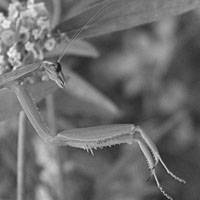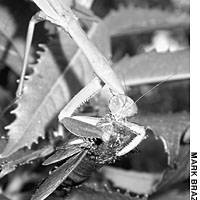The hunters are abroad! Every day, now, the sparrow hawks, goshawks, honey buzzards, ospreys and falcons that summer in Northeast Asia are migrating out of the region. As cooler weather approaches and prey numbers decline, these predators head south for the winter. Soon, almost on their heels, the larger birds, white-tailed sea eagles and magnificent Steller's sea eagles, will arrive here, but it will be some weeks before those enormous predators come in full force for our winter.
There is something awesome about predators; perhaps it is their speed, their power, and their apparent limitless rapacious capacity. But, even for nature lovers, seeing a predator actually dispatch its prey is rare. Predators are, among other things, cautious.
Hunting involves risks that should not be taken too lightly. It's hardly surprising that most predators spend considerable portions of their lives waiting for the right moment. They spend another portion attacking and not quite catching their prey; it takes many a pursuit before prey may actually be caught. As a result, even those of us who have spent a lifetime watching predators can generally remember clearly the few occasions on which we have seen a successful hunt brought to conclusion. So often I have seen hunter and hunted disappear out of sight not to return and knew that I was missing the final scenes of the drama. Occasionally, I have been in just the right place at the right time. More often than not it has been by pure chance.
Seeing a cheetah overtake its prey or a polar bear catch and haul off a seal are the dreamed-of events, more readily seen in a TV documentary than in real life, but set your sights a little lower, and you might encounter some surprises.
I recall one otherwise uneventful mountain hike during which I saw a jay, a colorful member of the crow family, leaping and pouncing strangely on the forest floor. These birds tend to eat large seeds and fruits, and I couldn't fathom at first what it was up to, but then it finally snatched its target and flew up and away with it -- a tail dangling from its beak bore witness to the demise of a small rodent. Not quite the thrill of watching a lion bring down a zebra, but exciting drama nevertheless.
Last week over the flanks of Kamuishiri, a favorite mountain of mine in west Hokkaido, I witnessed a strange series of predatory events. It was a mild early autumn day, and swarms of dragonflies seemed to be everywhere. The dragonflies' days are numbered now, and their gossamer wings rustling in flight seemed to presage the sound of falling leaves. Over the weeks of late summer these same dragonflies have been the hunters, chasing down smaller aerial insects on the wing, dashing like falcons. Every time I see one of them, I silently thank them for the inroads they make into the mosquito population!
High over the ridge leading to the summit, I spotted another winged shape, but this was sickle-winged and was in fact that fast-flying falcon, the hobby. I watched it jink and twist, dash and turn, turning so fast it seemed as if a kind of madness had overcome it. But then I realized what it was up to: It was chasing dragonflies! Suddenly a foot lashed out; the snatch was made; and in a gulp the dragonfly was gone, a hunter falling prey to another predator.
That dragonflies were plentiful came as no surprise; this is always an excellent time to see large numbers of them sunning themselves and lazily whiling autumn days away. What startled me was the number of hornets I encountered that day. At first I couldn't quite believe what they were up to. They were also hunting dragonflies! As I watched one cluster of 20-30 dragonflies sunning themselves on a wooden trail-side bench, a hornet zoomed in and grabbed one just as it was taking off. With much buzzing from the hornet and a prolonged dry rattling from the dragonfly, the hornet subdued the dragonfly with its deadly sting.
Using its sharp mandibles, the hornet then trimmed away the dragonfly's wings (perhaps as the dragonfly had done many times to its mosquito prey) and, grasping it with its feet, carried off the whole body, presumably to supply its nest somewhere in the forest.
I was stunned. I had seen hornets foraging before; I had watched them carving flesh from a post-spawning salmon lying dead in the shallows of a river. But this was the first time I had seem them actively hunt moving prey. Whatever the scale on which it takes place, there is something awesome about watching that rare moment as a pursuit predator realizes its full potential and brings down its prey.
Pursuit is not the only means that predators have at their disposal. Waiting and ambushing not only saves on energy expenditure, but also exposes the predator to fewer risks. Enormous patience is a prerequisite though. Over the years I have, on many occasions, encountered a master at this waiting game -- the praying mantis. Though I had marveled at this creature's bizarre morphology and wondered how its reactions could really be so fast as to allow it to catch passing prey, I had never imagined that I might one day see it in action.
I spent several days this autumn awaiting migrant birds on a small South Korean island off the coast of North Korea, and though the birding was fun, the most memorable sighting of the week was not avian at all. Insects were present in profusion -- dragonflies, butterflies and moths -- and in particular, there seemed to be hawk moths everywhere -- those strange day-flying moths that zoom up to a flower, hover in front of it, and extend their flexible proboscis down into it to suck up the nectar.
With proboscis extended forward and downward like a beak into the flower, these insects so closely resemble hummingbirds that people have been know to mistake them for birds. They buzz from flower to flower, hovering, inching forward, probing, backing out, refueling from the flowers' tanks of precious "aviation" fuel. That high-energy food enables them to fly long distances on migration; if, that is, they escape the hunters.
It was a pure fluke that seconds after one of my companions spotted a huge praying mantis, I spotted a hawk moth foraging at flowers less than a meter from it. It was an even bigger fluke when the hovering hawk moth strayed closer and closer to the mantis. The speed with which the mantis lashed out and with which the moth was meeting its end was so great that my companions and I stared at each other, as if to say, "Did we really just see that happen?" It was unbelievably fast, but there was the moth, now grasped tightly in one of the mantis' forelimbs, while with the other forelimb it steadily subdued its meal.
I have sought such spectacular moments among predatory mammals and birds from the Arctic to Antarctica, but never had I expected an encounter between two insects to prove the most exciting of all!
If you want to see even more remarkable photographs (not mine unfortunately) of minuscule hunters and prey please visit www.birdwatchersdigest.com and type the keyword "mantis" into the Web site's search engine.




















With your current subscription plan you can comment on stories. However, before writing your first comment, please create a display name in the Profile section of your subscriber account page.